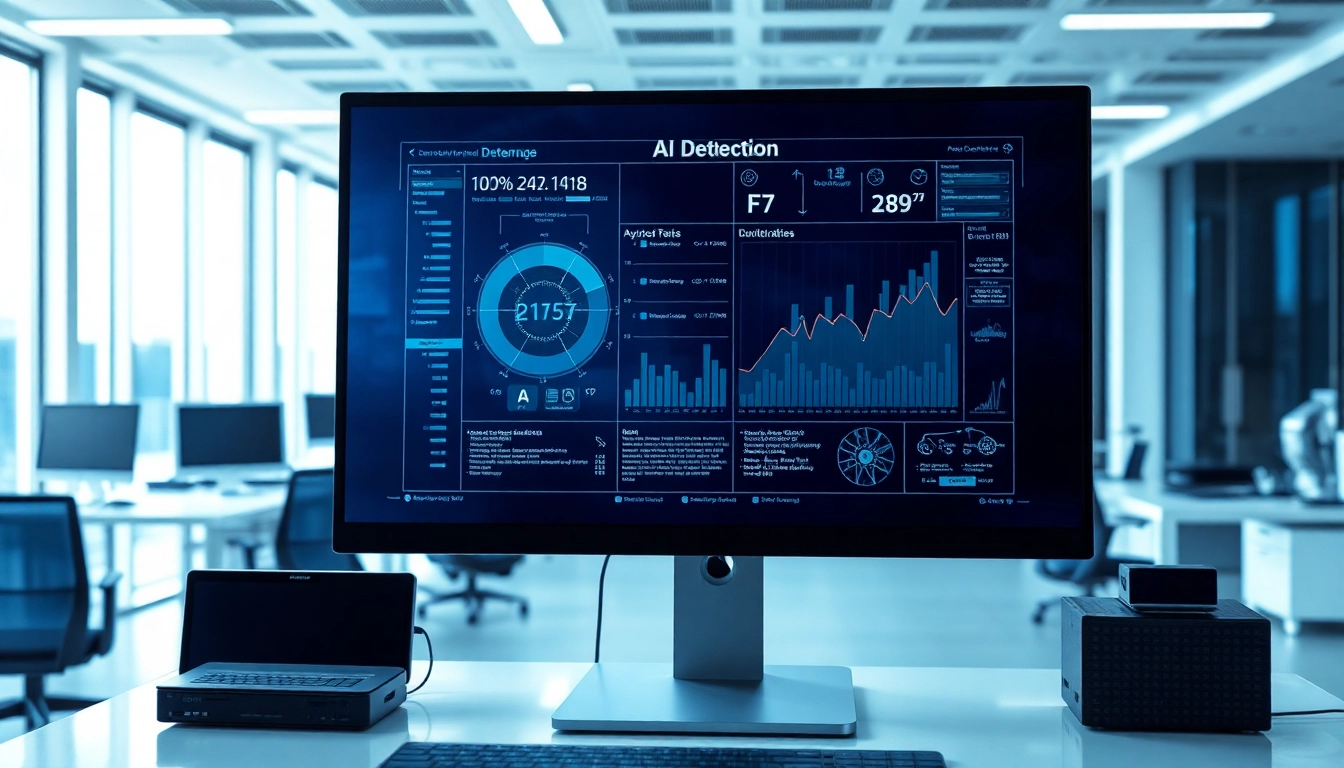Introduction to AI Detection
The emergence of artificial intelligence (AI) has transformed various industries, spurring innovation and efficiency. However, alongside these advancements arises a critical need for ai detection, aimed at discerning AI-generated content from human-created material. This article delves deep into the nuances of AI detection, exploring its mechanisms, significance, common misconceptions, applications, current challenges, and the future trajectory.
What is AI Detection?
AI detection refers to the methodologies and tools designed to identify text or content created by artificial intelligence systems. The rapid deployment of AI systems capable of generating coherent and contextually appropriate content raises concerns regarding authenticity, originality, and the potential for misuse. AI detection systems analyze various parameters of text—such as structure, syntax, and semantic coherence—to establish whether a piece of content is machine-generated or human-authored.
The Importance of AI Detection
The importance of AI detection cannot be overstated. In educational settings, it plays a pivotal role in maintaining academic integrity by identifying instances of AI impersonation in student submissions. In journalism and content creation, ensuring the authenticity of information protects against misinformation and enhances trust among audiences. Furthermore, businesses utilize AI detection to safeguard intellectual property and ensure compliance with ethical standards.
Common Misconceptions About AI Detection
Despite its growing significance, various misconceptions surround AI detection. One prevalent myth is that AI detection is infallible, capable of accurately identifying all AI-generated content. In reality, while these technologies are improving, they are not foolproof and may produce false positives or negatives. Another misconception is that all AI-generated content is inherently inferior or misleading; however, there are instances where AI tools can assist in enhancing creativity and productivity.
How AI Detection Works
The effectiveness of AI detection lies in its underlying mechanisms and the data it utilizes. Understanding how these tools function helps stakeholders apply AI detection more effectively across various domains.
Mechanisms Behind AI Detection Tools
AI detection tools utilize advanced algorithms and machine learning techniques to analyze text. Typically, these systems employ models trained on vast datasets containing both AI-generated and human-written examples. By analyzing patterns, such as word frequency, sentence structure, and complexity, these tools can evaluate the likelihood of a piece being created by AI.
Sophisticated AI detection methods include:
- Lexical Analysis: This involves examining the vocabulary and word choice in the text. Certain generative models may exhibit distinct lexical patterns that can be distinguished from human writers.
- Syntactic Analysis: Analyzing sentence structure and grammar helps identify anomalies typically present in AI-generated texts, which may differ in complexity compared to human writers.
- Semantic Analysis: This strategy involves assessing the meaning and context of the content. AI-generated text may lack nuances and contextual appropriateness found in authentic human communication.
Data Sources Utilized in AI Detection
The effectiveness of AI detection largely depends on the quality and diversity of the training data. These tools necessitate large datasets comprised of both AI-generated and human-created texts. Data sources typically include:
- Publicly Available Text: This includes books, articles, and online content freely accessible on the internet.
- Academic Papers: Scholarly articles provide a rich source of text for analysis, showcasing both formal and informal writing styles.
- Generated Content Samples: Feeding systems with samples from various AI tools—including different models and versions—enables them to learn to differentiate between generative styles.
Evaluating the Accuracy of AI Detection
Determining the accuracy of AI detection tools involves analyzing both their precision and recall. Precision refers to the proportion of true positive results within total positive results, while recall is the ratio of true positives to the total number of actual positives. High-performing AI detection systems should strive for a balance between these metrics to minimize both false positives (incorrectly identifying human text as AI-written) and false negatives (failing to identify AI-written text).
Common Applications of AI Detection
AI detection has a wide range of applications across industries, reflecting its critical role in maintaining authenticity and accountability in content creation.
AI Detection in Educational Institutions
Universities and schools increasingly adopt AI detection tools to uphold academic integrity. By identifying instances of AI-authored essays, theses, or other academic submissions, educational institutions can enforce standards for originality and authenticity. This not only promotes honest practices among students but also allows educators to tailor interventions to help students engage creatively and ethically with technology.
Using AI Detection in Content Creation
In the realm of content creation, AI detection serves as a valuable ally for writers and editors. Freelancers and content agencies utilize these tools to ensure the authenticity of articles, blogs, and digital content while protecting their reputation. By employing AI detection tools, they can ascertain whether a piece of content has relied heavily on AI assistance or generated entirely by algorithms, thereby enhancing content credibility.
Ethical Considerations in AI Detection
While AI detection aids in transparency, it introduces a series of ethical considerations. Questions surrounding privacy arise, particularly when monitoring student submissions or professional content. Furthermore, the possibility of bias in detection algorithms must be addressed. Ensuring fair evaluation across diverse writing styles and backgrounds is critical to maintaining the integrity of AI detection systems.
Challenges in AI Detection
Despite the growth and development of AI detection technology, significant challenges remain that impact its efficacy.
Limitations of Current AI Detection Technology
Current AI detection tools often struggle with detecting certain types of nuanced or stylistically unique writing. The more sophisticated and human-like AI-generated content becomes, the more difficult it is to discern its origin. Furthermore, most detection algorithms require continuous updates to adapt to evolving AI generation techniques, necessitating ongoing investment in research and development.
Addressing False Positives and Negatives
False positives and negatives present ongoing challenges for AI detection systems. These discrepancies can lead to misclassifying genuine human work as AI-generated or vice versa. To mitigate this, developers remain focused on refining algorithms and integrating a feedback loop where user corrections to misclassifications can improve the model’s future accuracy.
Future Trends in AI Detection Development
The future of AI detection holds promise as technologies evolve to become more sophisticated. Anticipated trends include:
- Integration with Learning Systems: AI detection algorithms will likely become intertwined with educational platforms, ensuring automatic checks during submission.
- Improved Contextual Understanding: Advanced machine learning models will develop a deeper semantic understanding, facilitating greater accuracy in detecting contextually relevant nuances.
- Real-Time Analysis: Future AI detection tools may incorporate real-time analysis capabilities, allowing users to identify AI-generated content instantaneously during the writing process.
Conclusion: The Future of AI Detection
As AI technologies continue to evolve, the significance of AI detection will only increase. Its potential to influence various sectors raises vital discussions about ethics, transparency, and accountability.
Integrating AI Detection into Regular Practices
Implementing AI detection into standard operating procedures across industries is essential for fostering responsible AI usage. This integration can facilitate training programs for educators, provide resources for content creators, and promote a culture of authenticity in digital practice.
Impacts of AI Detection on Industries
The impact of AI detection extends beyond individual sectors. By establishing consistent standards, industries can collaborate to enhance overall content quality and improve trust in digital communications. Furthermore, advancements in AI detection can lead to broader applications in identifying misleading or dangerous AI-generated content in areas like social media and journalism.
Final Thoughts on AI Detection and Its Role in Society
AI detection represents a critical intersection between innovation and integrity. As the line between human and AI-generated content continues to blur, society must adapt to ensure authenticity prevails. By embracing robust AI detection practices, stakeholders can pave the way towards a future where technology enhances rather than undermines trust and credibility in content creation.



